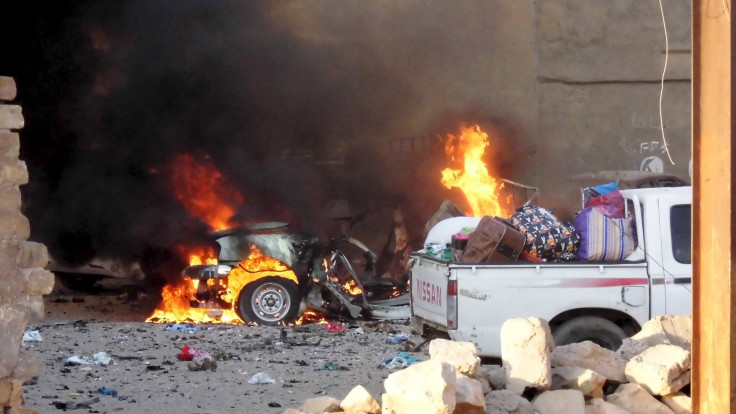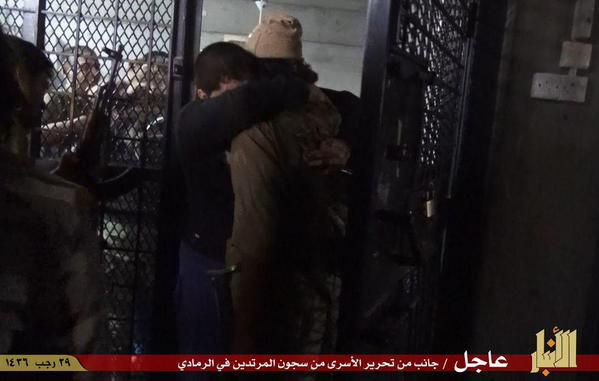After ISIS Executes Hundreds In Ramadi, Shiite Militias, Sunni Tribesmen Join The Battle For Anbar

ISIS fighters and Iraqi prisoners appeared smiling and hugging in photos released by the Islamic State group from the Iraqi city of Ramadi on Monday. Iraqi officials had already announced that the city had fallen to ISIS militants, who then reportedly broke into a Ramadi prison, celebrating their long-awaited victory. But hours later, videos and photos showed rows of tanks and pickup trucks bearing the various logos of Iraq’s Shiite militias racing to the same city to fight the ISIS militants. Shiite militias have long been one of the biggest threats to ISIS on the ground, but in the Sunni city of Ramadi, civilians are worried they will bring additional danger.
Militants from the group known as ISIS killed more than 500 Iraqi Security Forces (ISF) and civilians over the weekend and on Monday leading up to the capture of Ramadi. Another 8,000 residents were forced to flee the city, fearing for their lives. But even after roughly three days of heavy fighting and executions, the battle for Ramadi is still not over. Instead, it has drawn in additional players, which some said may only increase bloodshed and displacement of the civilian population.

On Friday, ISIS militants reportedly dressed as ISF members detonated 10 suicide bombs outside Ramadi’s central government building.
“By the next day, there was an IS [Islamic State group] flag flying over part of the complex,” prominent Iraqi analyst Joel Wing wrote on his blog Musings On Iraq.
After the initial suicide attacks, the militants reportedly began searching the city for residents affiliated with the government and the army “to execute,” according to Wing. They managed to find 500 people to kill. In the following days leading up to the fall of Ramadi, ISIS executed at least another 50 people. ISF reinforcements never arrived.
ISIS had been eyeing Ramadi for months and making strategic moves in the surrounding area as early as December 2014 when the group launched several attacks in and around Ramadi, “in preparation for a wide-scale offensive” in the city, according to a report from the Institute for the Study of War. In early May, ISIS began its usual strategy of conducting several smaller attacks around the city before the full-scale ground operation.
Ramadi fell to ISIS on the night of Sunday, May 17, 2015. The next day, on May 18, 3,000 Iraqi Shiite fighters raced to Ramadi at the request of Iraqi Prime Minister Haider al-Abadi, who claimed the militias were necessary to fight ISIS, even though the White House insists otherwise.
Among the Shiite militias fighting in Ramadi is reportedly Kataib Hezbollah, a group affiliated with the Lebanese armed political group Hezbollah and one that's on the U.S. State Department’s list of foreign terrorist organizations.
Social media accounts of the situation in Ramadi included photos of Kataib Hezbollah convoys, flags and fighters driving into Anbar province after al-Abadi’s call. The militia had already been fighting off ISIS militants in the neighboring city of Fallujah for several days, according to the Kataib Hezbollah website.
#الحشد_قادم قوات ضخمة وأرتال مهيبة لكتائب #حزب_الله تتوجه الى #الأنبار وتستعد لساعة الصفر لتطهير مدينة #الرمادي pic.twitter.com/NR9SmeWHVQ
— Mustafa AlShakarchi (@mgsiraq) May 17, 2015ارتال من كتائب حزب الله تتوجه الى الرمادي #الحشد_الشعبي_المقدس #كتائب_حزب_الله #الجيش_العراقي_الالكتروني pic.twitter.com/yrwXXeJgcr
— ali al Moussawi (@alMoussawi2) May 18, 2015The presence of Shiite militias could pose another threat to civilians left in Ramadi. Anbar province, of which Ramadi is the capital, is a Sunni-dominated region in central Iraq where ISIS has managed to stir up some support from civilians. The incoming Shiite militias were a concern to some residents, who fear the Shiite fighters as much as the ISIS militants.
"If the Shiite militias enter Ramadi, they will do the same things being done by Daesh," Abu Ammar, a native of Iraq’s Anbar province, who owns a grocery store in Ramadi told the Associated Press. "In both cases, we will be either killed or displaced. For us, the militias and IS militants are two faces of the same coin."
Meanwhile, roughly 4,000 Sunni tribal fighters have deployed in the south of Anbar province to push back ISIS militants coming from Ramadi, according to Reuters.
"The message that we pass it to the U.S. side includes the need to deliver the needed weapons to fight Daash [ISIS] ... and support the security forces close to the city and ready to fight,” Anbar governor Ethel al-Nujaifi said at a press conference Sunday, referring to ISF, the Shiite militiamen in the national mobilization forces and Sunni tribal fighters.
This new fight against ISIS in Ramadi is similar to the battle in Tikrit, another predominantly Sunni city, and is likely to become a pattern in pushing ISIS militants back in Sunni Anbar province. In Tikrit in March, roughly 12,000 Shiite militia fighters partnered with Iraqi Security Forces to retake the city that had been under ISIS control since last June. An estimated 2,000 Sunni tribal fighters also joined the the fight.
“As the conflict in Ramadi develops, tribal revenge attacks will be bloody, whichever way it ends,” Hayder Al-Khoei wrote in an Op-Ed piece for Reuters. Al-Khoei is an associate fellow with the Middle East and North Africa Programme at Chatham House, an independent policy institute based in London.
© Copyright IBTimes 2025. All rights reserved.





















